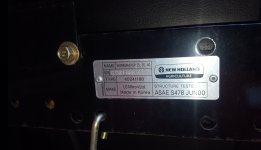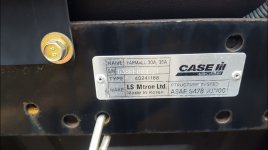Most loaders have standard and optional buckets. Establishing a lift standard "at the pin" is the easiest and most universally standard measurement that can be easily replicated. The standard is the same regardless of the size or weight of the bucket, grapple, forks, whatever. If people can't read a specification and understand it, that's on them.
A rating of X at the pins does not mean the loader will lift X center mass at the cutting edge of the bucket. But too many tractor buyers simply can't or won't grasp that.
I agree. Rating at the pins is the only way to compare apples to apples (or as close as one color of apples can get to another). Buckets aren't the only thing that goes on a loader. When I bought my tractor my intention was to use it primarily as an offroad forklift. If I had to compare lifting capacities from brand A who rates it at the cutting edge of a 200lb bucket against band B who rates it at center mass of a 300lb bucket, vs brands C, D, and E, who rate theirs 3 other different ways, I would have a lot of work to determine to which one could lift more at center mass of a 48" pallet fork attachment. "At the pins" is the standard, and I for one think it's a good standard, whether it reflects real world achievable results or not.
To the original question, I have not seen much fudging of numbers in tractor specs. I suspect this is because this is one area where the numbers actually matter. It's not like a "5HP" shop vac that nobody ever puts to the test and actually needs or expects to hit 5HP, and most don't even know how to verify the claim. It would be a lot harder to get away with it in a tractor. If the tractor advertised a certain GPM and you use an implement which requires that GPM, you're going to know right away that it was an inflated rating and demand a refund. I suspect this is more trouble than its worth for the manufacturers, so they must find it more beneficial to advertise the truth. Maybe with some asterisks. Read the asterisks.
For those talking about the fit & finish of Korean tractors, I am curious what you think about the "American" CUTs by New Holland and Case IH.
I took these pictures last year at the county fair:


I bought an LS branded LS tractor and I got the same tractor as a Case / New Holland but for thousands less. And the loader that LS puts on them is much more stout than those Red and blue ones. It's a better loader than comparable Kubota and Mahindra models. I'm talking about the construction of it, not the specs. You can see the difference plain as day, just go look at them, take pictures, bring a pair of calipers if you want. LS is using 1" thick steel plate in places where Kubota is using 1/4" plate, and JD is using cast iron.
This wasn't supposed to be a promo for LS, just a counter example for the assertion that Korean = inferior in any way whatsoever. You DO get what you pay for, and what you are paying for is too often just a name.


